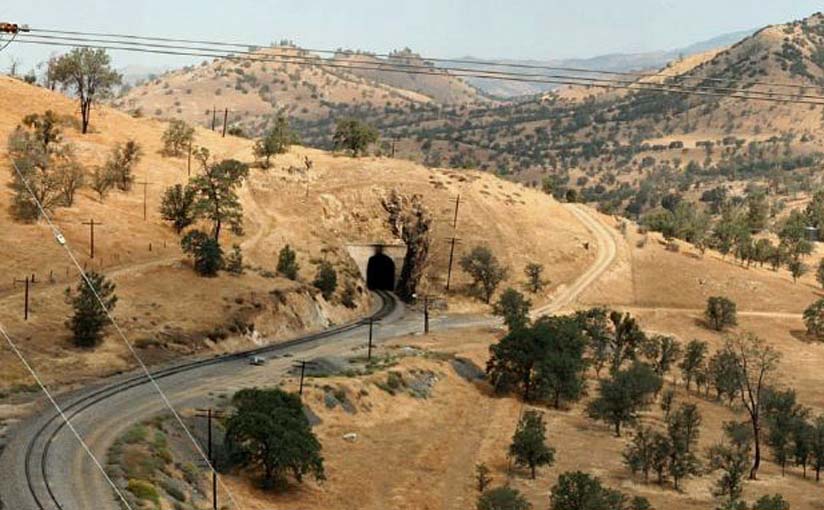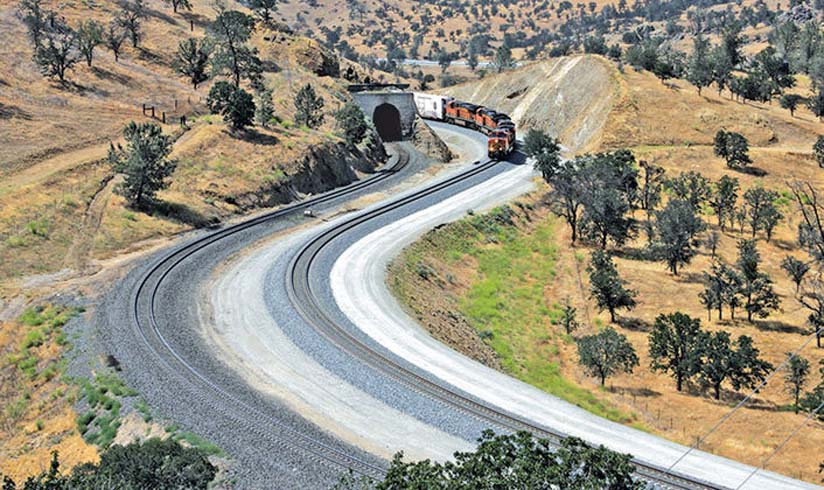

A US$106.7 million rail improvement project that is winding its way through the approval process would increase freight train traffic through the Tehachapi Pass by about 80 percent by 2020.
By 2020, the existing rail line is expected to reach an average of 50 8,000 foot trains per day instead of the current average of 35 trains per day.
Local residents will have a chance to learn more about the project, and share their thoughts on a Draft Environmental Impact Report (DEIR) that has been prepared, at a meeting to be held 27 Sep 2012.
The so-called "double tracking", also known as the Tehachapi Rail Improvement Project, will be the subject of a California Environmental Quality Act public hearing and open house from 18:00 to 20:00 on 27 Sep 2012 at the offices of the Tehachapi Area Association of Realtors, 803 Tucker Road, Tehachapi, California.
Drop in any time during that period to meet with members of the project team, review project maps, and make comments.
The DEIR for the project has just been released.
The report describes the potential impacts and mitigation related to construction of an additional track along five rail segments within the Tehachapi Pass area.
New and temporary bridge structures and the extension of existing culverts are also improvements proposed as part of the project.
Three alternatives are under consideration, the Build Alternative, Reduced Segment Alternative, and the No-Build Alternative.
Having such alternatives is a requirement of CEQA and the project is covered by CEQA, according to a CalTrans representative, because it is receiving state and federal funds.
If the railroad was funding the improvements entirely on its own the Environment Impact Report (EIR) would not be required.
The project consists of five segments north of State Route 58 and State Route 223, running through the towns of Caliente and Keene.
Traveling from west to east, the project would add a second rail segment parallel to existing track.
This process is called double tracking.
The Tehachapi Loop would not be changed, but additional track would allow more train traffic to move through the area.
Rail service through the Tehachapi Pass is experiencing worsening congestion, a growing volume of rail traffic, and increased delays.
The volume of goods transported through the Tehachapi Pass have greatly increased in the past decade.
In addition to rail transportation, the only major means of access across the Tehachapi Mountains between the Central Valley and eastern points such as Las Vegas and Phoenix is through State Route 58, a four-lane expressway with traffic controls in many segments.
About 30 percent of the traffic on this portion of this expressway is truck traffic.
Rapid growth in Bakersfield in recent years has also added traffic and congestion.
This trend is expected to continue.
The purpose of the project is to improve operational capacity, increase efficiencies, and reduce operational constraints that limit efficiencies of rail freight movement across the Tehachapi Mountains.
The BNSF Railway plans to partner with the state, providing matching funds to cover the project costs.
Half of the construction funding would come from BNSF Railway and the rest from the California Transportation Commission with funds from Transportation Corridor Improvement Fund.
In addition to the 50 percent private match, future maintenance of the new rail infrastructure would be privately funded by the railroads.
It is expected that the freight increases from 2010 to 2020 will increase by nearly 80 percent from 7,985 containers to 14,000 containers per day.
BNSF Railway estimates this growth in freight volume based on its year-to-year market growth projections, which indicate that additional track capacity is necessary to avoid making an already-congested rail corridor worse.
Although the actual construction will take place west of the City of Tehachapi, the city will be impacted because the project will allow much more train traffic than is currently seen.
"It will increase the number of trains coming through town in frequency but also the length of the trains," said David James, Community Development Director for the city.
"We already have an issue with having very few rail separations (space between crossings) so that's a real public safety concern of ours, as city employees. Trains coming through town, other than maybe visitors who want to stop and take pictures of them, have very little economic impact on us. But, it certainly does impact our quality of life."
He said city staff will be reviewing the EIR very critically to see how the issue of our grade separation is addressed.
Copies of the EIR document as well as the technical studies are available for review at the Caltrans district office at the Kern County Library, Tehachapi Branch at 1001 West Tehachapi Boulevard, Suite A-400.
The document can also be accessed electronically at the CalTrans website.
Written comments can be mailed to Bryan Apper, Sr. Environmental Planner, CalTrans, 855 M Street, Suite 200, Fresno, CA 93721.
Caltrans will be accepting comments until Friday, 12 Oct 2012.
Ed Gordon.
 Looking at the present track plan of the Loop area one wonders why the railway didn't bore a second tunnel at Walong and continue double-tracking westwards to Woodford siding. It would entail the construction of two more bridges as well so perhaps the cost is prohibitive at this time.
Looking at the present track plan of the Loop area one wonders why the railway didn't bore a second tunnel at Walong and continue double-tracking westwards to Woodford siding. It would entail the construction of two more bridges as well so perhaps the cost is prohibitive at this time.
provisions in Section 29 of the Canadian
Copyright Modernization Act.










